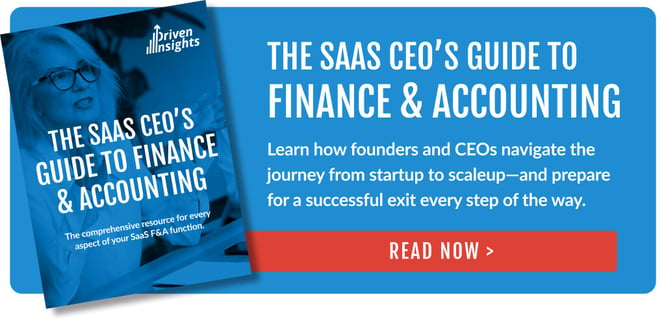
Valuing SaaS companies is complicated. Every business model is unique, every deal is nuanced, and markets are constantly evolving. With so many factors involved, it’s no wonder that buyers, investors, and sellers often arrive at very different numbers. And, it’s no surprise that questions abound.
What methods do investors and buyers use to increase or decrease valuation? How do they value companies relative to one another? Is there a single “best” metric that drives valuation?
In this article, we’ll answer these questions and more by exploring two common valuation methods—SaaS ARR and EBITDA. You’ll learn how each of these metrics can serve as an indicator of a company’s financial performance, and which translates into a more reliable measure of value.
With a clear grasp of how these methods work, you’ll understand how investors or buyers really determine the value of SaaS companies, so you can position yours for maximum valuation and safely estimate its worth.
SaaS Companies are Valued Differently
SaaS companies vary from traditional businesses in several ways, resulting in a different valuation process for a subscription business. Compared to other business models, SaaS companies are characterized by:
- Recurring revenue, rather than one-off purchases
- Lower cost to serve, with higher gross margins per customer
- Renewal rates and retention, a key driver of long-term success
- Expansion revenue generated from an installed base
SaaS companies aren’t subject to the limitations of physical inventory, shipping logistics, or supply chain issues like many traditional businesses. It’s a model designed for rapid, efficient growth.
When it comes to valuation, investors can choose from many different performance measures and business attributes to assess, but there is one universal principle. Above all else, the value of a SaaS business is determined by the present value of its future cash flows.
In other words, the value of a company today is based on an estimation of its future profits. You might then assume it’s time to use the discounted cash flow method. But in practice, the use of a “multiple” typically serves as a proxy for this estimate and the driver of SaaS value.
What are SaaS Valuation Multiples?
How can the current value of a company be determined by its future performance? The answer to this question: Valuation multiples.
The value of a SaaS business is commonly calculated by selecting a valuation metric, such as ARR or EBITDA, and multiplying it by a seemingly mysterious number, called a “multiple.” The size of the multiple will be influenced by any number of factors, from key SaaS metrics such as ARR, its revenue growth rate and gross margins, to the age of the business, to market conditions.
While the multiple is the wild card in the valuation process, it’s important to understand which valuation method is most appropriate for your business in order to aim for the highest multiple. In other words, asking yourself: “Should we use an EBITDA or ARR multiple?”
In some cases, a multiple of ARR will be the preferred calculation. In other cases, it may be EBITDA. Next, we’ll break down both methods and when to use them.
Because SaaS companies leverage a scalable, cloud-based, subscription model, they can often prove product/market fit, generate recurring revenue, and build momentum faster than other online business models, such as ecommerce stores. This potential for rapid growth translates into larger multiples for SaaS businesses, but there is still a high degree of variability and guesswork.
Recurring revenue and the subscription model are what sets SaaS businesses apart when it comes to valuation. While Annual Recurring Revenue (ARR) growth isn’t a standalone metric, when combined with churn, it does point to product/market fit, increased demand, and the potential for future earnings at scale—all strong signals for investors and buyers.
A valuation using ARR isn’t focused on current cash flow. It relies on a track record of revenue performance coupled with KPIs that highlight a SaaS firm’s unit economics as a predictor of future profit potential. For growing SaaS companies, that’s often the strongest indicator of a solid investment opportunity.
For companies that aren’t yet profitable, an ARR-based valuation is the preferred method—and will result in a higher multiple.
When should Annual Recurring Revenue be used for SaaS Valuation?
The fact is, most SaaS firms in the stages we’re contemplating—from product/market fit through to the scaling stage—are primarily valued using a multiple of ARR, in no small part because it’s common for growing firms in these stages to have a negative EBITDA. ARR is often used in conjunction with gross margin, Monthly Recurring Revenue (MRR) to provide a comprehensive view of a SaaS company's financial health. But that reality doesn’t entirely shut the door on EBITDA valuations as there are many cash flow-based investors and buyers in the market.
EBITDA as a SaaS Valuation Method
EBITDA stands for Earnings Before Interest, Taxes, Depreciation, and Amortization. It is a measure of a company’s current cash flow, and puts the focus on profitability, rather than revenue. High customer churn can significantly impact a company's profitability and cash flow, making EBITDA a sensitive metric for early-stage SaaS businesses.
EBITDA brings the current, operating profitability of a company into focus by removing factors that are unique to every business (interest, taxes, depreciation, and amortization). For most traditional businesses, current earnings can serve as a proxy for future cash flow, making EBITDA an effective basis for valuation. But this isn’t always the case for early stage SaaS businesses.
For growing SaaS companies, current cash flow often isn’t a solid indicator of future performance. In fact, it is common for SaaS companies to generate no profits—or even lose money— in the early stages. However, once they achieve product/market fit, establish a repeatable sales process, and begin to scale, earnings can increase dramatically. For businesses that are still burning cash, using EBITDA to predict future performance is a poor basis for valuation.
When can EBITDA be used for SaaS valuation?
Under certain conditions, current cash flow can be a reliable premise for valuation. For established SaaS companies with a substantial base of paying customers, EBITDA can provide a compelling picture of financial health. For established SaaS companies with earning power above $5 million ARR, or early-stage firms with a slow growth curve, EBITDA may still be used as the primary basis for valuation. As with traditional companies, there must be demonstrated profitability to signal future potential.
Using ARR and EBITDA Together for SaaS Valuation
While there are distinct criteria for valuation with ARR and EBITDA methods, both can work together to build a more complete picture. Triangulating toward a valuation separately using ARR and EBITDA multiples can be an effective method to confirm the result of one valuation method with another. It's also common to apply an ARR multiple to ARR for subscription revenue AND to apply an EBITDA multiple to the EBITDA of professional services.
For example, a SaaS firm that produces ARR from subscription revenue can also generate one-time revenue from services like implementation or customization projects. Using both valuation methods together will account for the future profit potential of the ARR, as well as the current cash flow provided by one-time, non-recurring revenue.
Customer Acquisition Cost and Other Factors that Impact SaaS Valuation
ARR may be an effective means of predicting future profits, and EBITDA may be a useful way to gauge current cash flow, but other factors must be considered when valuing a SaaS company. Customer success initiatives are also crucial, as they directly impact customer retention and overall business health. Investors, buyers, and sellers should also draw from several key SaaS metrics intrinsic to the long-term value and viability of a business.
These core metrics will influence the multiple used to determine value, and include customer acquisition cost (CAC), customer lifetime value (CLV, LTV or CLTV), churn, growth rate, gross margin, long-term revenue projections and more. Multiples will also be adjusted with respect to market size, the age of a business, dependence on level of founder/owner involvement, and other factors. Evaluating a SaaS business without these other considerations may leave money on the table and give fodder to a buyer or investor to ratchet the valuation down.
Accurate ARR Begins with Revenue Recognition
ARR is the “go to” valuation driver for most SaaS growth firms, but before we wrap up, let’s celebrate the unsung hero of an accurate ARR—revenue recognition. Accurate revenue recognition practices are essential for tracking revenue from existing customers and ensuring financial credibility.
One of the first things a potential buyer or investor will scrutinize during due diligence is a SaaS firm’s revenue recognition practices and figures. Revenue recognition refers to the accounting practice whereby revenue is matched with the period in which it was earned. This can become complex with the SaaS subscription model because customers are often paying for services before they are delivered, and terms can vary from customer to customer.
Failing to track your firm's revenue accurately will lead to cascading problems with metrics, and problems here can lead to severe devaluation or even a buyer walking away from the table. Water tight revenue recognition practices are essential to a complete SaaS finance and accounting function, and will add to the credibility of your overall financial story.
Maximizing the Value of Your SaaS Company
Solid financials and accurate data are the keys to presenting the best version of your story to investors and potential buyers. They are also critical to setting your expectations, so you’re not overestimating (or underestimating) the value of your business.
One of the biggest challenges growing SaaS firms face is right-sizing their finance and accounting function. From high-level finance leadership and oversight, to essential accounting roles and systems, it’s critical at each stage to have all the right pieces in place.
To learn how an outsourced CFO service for SaaS businesses offers a complete solution for every stage of growth, schedule an introduction to Driven Insights. You’ll receive a free proposal and discover a cost-effective way to have all the finance resources your business deserves, today and as you grow.








